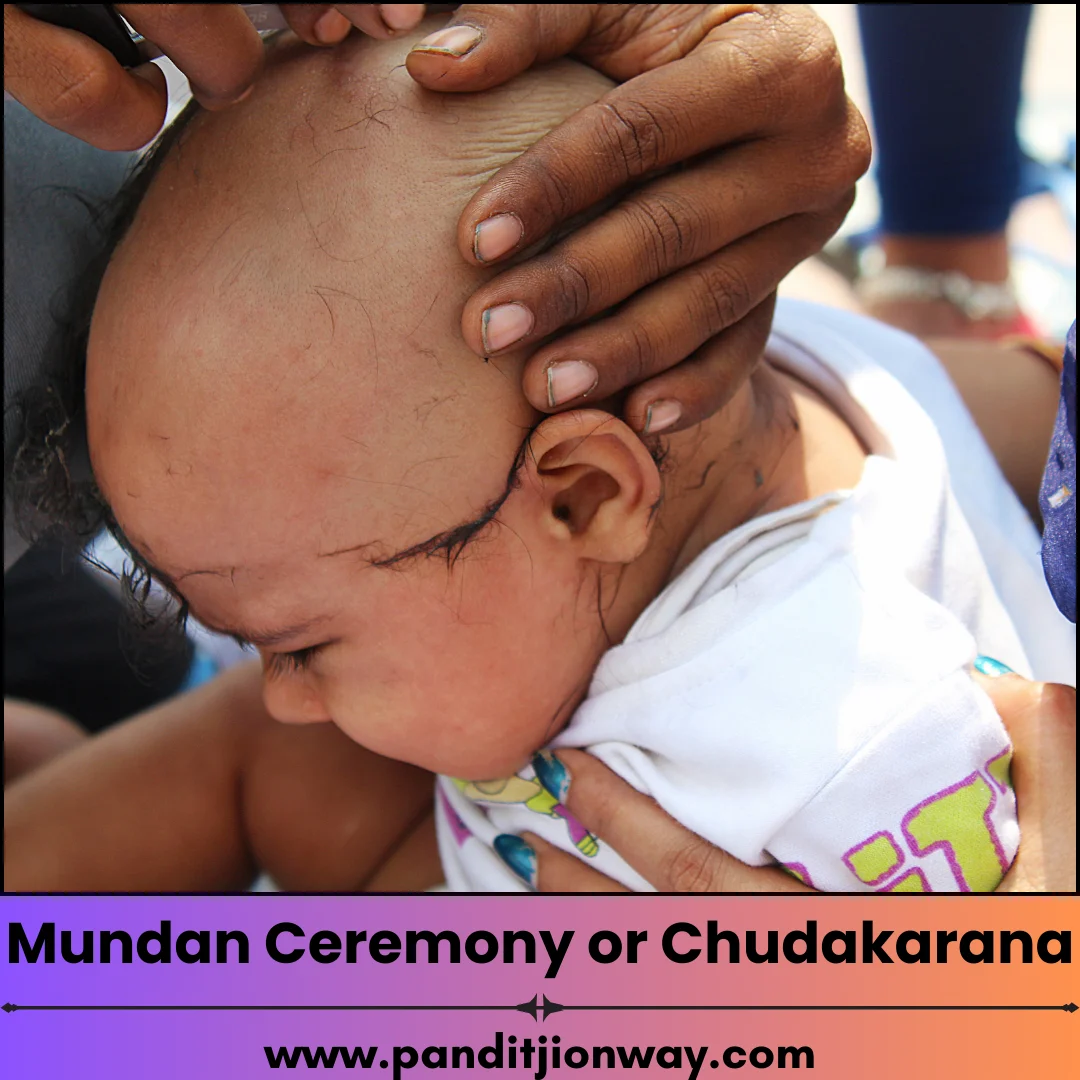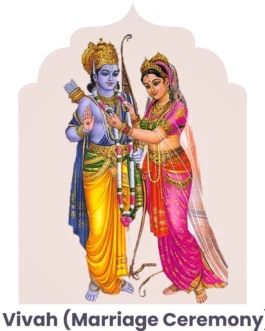Mundan Ceremony (Chudakarana) | Pandit For Mundan Sanskar
$39.48
Book Vedic Pandit for Mundan Ceremony (Chudakarana) with Complete Puja Samagri
Make your child’s Mundan Sanskar divine and hassle-free with our expert Vedic Pandits for Mundan Ceremony, available at your home or preferred location. We provide complete Puja Samagri, Muhurat calculation, and traditional rituals as per Hindu customs. Ensure a spiritually pure and auspicious start for your baby with an authentic Mundan Ceremony performed by trained Pandits. Book now for a sacred and memorable experience!
Description
Mundan Ceremony (Chudakarana) | Pandit For Mundan Sanskar
The Mundan Ceremony, also known as Chudakarana, is one of the most important samskaras (rites of passage) in Hindu tradition. Typically performed during the first or third year of a child’s life, this ritual signifies the shedding of the child’s past karma and the start of a new, spiritually aligned chapter. It is deeply rooted in Vedic traditions and continues to be celebrated with devotion across India and among Hindu families worldwide.
What Is the Significance of the Mundan Ceremony?
The Mundan Ceremony is more than a cultural milestone; it is a spiritual purification ritual. According to Hindu scriptures, a child’s birth is not just a biological process but a continuation of the soul’s journey. The first hair on a baby’s head is believed to carry traits from past lives, and by shaving it off, the child is freed from negativity, paving the way for healthy development, mental clarity, and spiritual growth.
Key Highlights of the Mundan Ceremony
- Ideal Age for Mundan: The ritual is usually performed during the 1st or 3rd year of life, often determined by a muhurat (auspicious timing) calculated by a qualified Pandit.
- Purpose: To eliminate past-life impressions, enhance intellectual and physical development, and offer spiritual cleansing.
- Shikha: In many traditions, a tuft of hair (Shikha) is left at the crown, representing the seat of wisdom.
- Deities Worshipped: The ceremony includes prayers to Lord Ganesha, Goddess Lakshmi, and the Navgrahas (Nine Planets) to invoke blessings.
- Mantras and Offerings: Special Vedic mantras, havan (fire rituals), and prayers are conducted for the child’s well-being.
Why Perform the Mundan Ceremony?
Here are some spiritual and traditional reasons why the Mundan Ceremony is considered essential:
- Removes Negative Karma: Helps remove any residual energy or karma from past lives.
- Enhances Brain Function: Shaving the head is believed to stimulate the nerves and brain cells.
- Improves Hair Growth: Scientifically, this ritual promotes healthier and stronger hair growth.
- Cleanses the Aura: It purifies the child’s aura and surroundings for a fresh start.
- Promotes Longevity and Prosperity: The blessings received during the ritual are believed to secure a long, healthy, and prosperous life.
What Happens During the Mundan Ceremony?
A typical Mundan Ceremony involves the following steps:
- Ganapati Puja: The ritual begins with prayers to Lord Ganesha for obstacle-free completion.
- Invocation of Deities: The Pandit invokes the Navgrahas and other deities for divine blessings.
- Shaving of Hair: The child’s hair is shaved with mantras recited by the Pandit. In some families, a few strands are offered to a sacred river or buried in holy ground.
- Havan and Puja: A sacred fire (havan) is lit, and offerings are made.
- Blessings: Elders and guests bless the child with health, wisdom, and success.
- Feast and Celebration: A traditional meal or Brahmin Bhojan is arranged to conclude the ceremony.
Book Your Vedic Pandit for Mundan Ceremony with PanditJi On Way
At PanditJi On Way, we are committed to delivering a seamless and spiritually enriching experience for your child’s Mundan Ceremony. We provide:
Experienced Vedic Pandits
All our Pandits are well-trained in Vedic scriptures, hailing from reputed Gurukuls and Pathshalas.
High-Quality Puja Samagri
We offer authentic and premium quality Puja Samagri, ensuring every ritual is performed as per traditional standards.
Custom Muhurat Calculation
Our experts provide muhurat analysis based on your child’s birth details, ensuring the ceremony is performed at the most auspicious time.
Complete End-to-End Service
From venue setup to ritual execution, we manage everything with attention to detail.
Book your Pandit today at https://www.panditjionway.com to make your child’s Mundan Sanskar a memorable and divine experience.
Frequently Asked Questions (FAQs) About Mundan Ceremony (Chudakarana)
1. What is the Mundan Ceremony in Hinduism and why is it performed?
Answer: The Mundan Ceremony, also known as Chudakarana, is a Hindu ritual where a baby’s first hair is shaved off. It is performed to cleanse the child of any negative energies or karmic influences from past lives and to ensure a healthy and prosperous future. It is one of the essential 16 Hindu Samskaras.
2. At what age should Mundan Sanskar be performed for a baby boy or girl?
Answer: The ideal age for Mundan Sanskar is usually during the first or third year of a child’s life. The specific date is chosen based on astrological calculations (muhurat) considering the baby’s birth chart, which is why consulting a qualified Pandit is important.
3. Can Mundan Ceremony be done at home? What is the right place to perform it?
Answer: Yes, the Mundan Ceremony can be performed at home, at a temple, or at a holy place like the banks of the Ganga River or other sacred rivers. The chosen place should be clean, peaceful, and spiritually charged to conduct the ritual properly.
4. Who performs the Mundan Ceremony and what items are needed?
Answer: A certified Vedic Pandit conducts the ceremony by chanting Vedic mantras and performing the Havan (sacred fire ritual). Items required include Puja Samagri, a barber with sterilized equipment, ghee, cotton, rice, sandalwood, sacred water, and offerings to the deities.
5. What are the benefits of doing Mundan Sanskar for children?
Answer: The spiritual benefits of Mundan Sanskar include purification of the soul, removal of previous birth’s karmic residue, and blessings for intelligence, health, and long life. Scientific benefits also include improved blood circulation, scalp health, and better hair growth.
6. What happens to the hair after the Mundan Ceremony is completed?
Answer: After the Mundan, the shaved hair is typically immersed in a holy river like the Ganga or buried in a sacred place. This act symbolizes the child’s detachment from previous karma and entry into a purified life path.
7. Is Mundan Ceremony necessary according to Hindu tradition?
Answer: Yes, it is considered one of the 16 essential Hindu rites (Shodasha Samskaras). While it may not be legally mandatory, it holds significant spiritual and cultural importance for devout Hindu families and is highly recommended by Vedic scriptures.
8. How do I book a Pandit for Mundan Ceremony with Puja Samagri included?
Answer: You can book a qualified Vedic Pandit for the Mundan Ceremony through PanditJi On Way, where you get complete service including Puja materials, Muhurat consultation, and experienced priests who follow Vedic traditions precisely.
9. Can the Mundan Ceremony be combined with other rituals or ceremonies?
Answer: Yes, many families combine Mundan Sanskar with Annaprashan (first feeding) or Namkaran (naming ceremony) to make it a grand occasion. Your Pandit can guide you on how to combine rituals according to your family tradition and regional customs.
10. What should the child wear during the Mundan Ceremony?
Answer: The child should be dressed in comfortable and traditional attire, such as a dhoti or kurta for boys and a lehenga or frock for girls. After the head is shaved, the child is bathed and redressed in clean, sacred clothes before receiving blessings.
11. Is there any scientific benefit to Mundan?
Answer: Yes. Shaving the head is said to stimulate nerve endings and improve blood circulation, which can support brain development and healthier hair growth.
12. What should we do with the shaved hair?
Answer: The hair is either immersed in a holy river (like Ganga) or buried in a sacred spot. This is believed to remove the child’s past karma.
13. What is the significance of leaving a Shikha (tuft of hair) during the Mundan Ceremony?
Answer: In many Hindu traditions, a Shikha (small tuft of hair) is intentionally left on the crown of the child’s head during the Mundan. This area is considered the Sahasrara Chakra or the center of spiritual energy. Leaving a Shikha is symbolic of preserving wisdom, focusing spiritual energy, and honoring Vedic traditions.
14. How long does the Mundan Ceremony take and what preparations are needed?
Answer: The Mundan Ceremony typically lasts 1.5 to 2 hours, depending on the specific rituals included. Preparations involve selecting an auspicious date (Muhurat), arranging Puja Samagri, booking an experienced Pandit, preparing the child’s clothes, and optionally organizing a small gathering or feast for family and friends.
External Resources for Reference
- Hinduism Today – Samskaras – A detailed guide on Hindu rites of passage.
- Indianetzone – Mundan Sanskar – In-depth information on Mundan Ceremony traditions.
- Times of India – Significance of Mundan Ceremony – Cultural and spiritual overview.
Final Thoughts
The Mundan Ceremony is not just a family ritual but a profound spiritual gateway for your child. It symbolizes the beginning of a fresh journey in life—free from past karmic baggage and full of divine blessings. By performing this sacred ritual with devotion and proper guidance, you are investing in your child’s physical, mental, and spiritual well-being.
Let PanditJi On Way be your trusted companion in making this auspicious occasion smooth, authentic, and deeply fulfilling. Visit www.panditjionway.com to schedule your Chudakarana Ceremony with our expert Vedic Pandits today.
Additional information
| Package | Economy : (1 Panditji + All Puja Samagries) |
|---|







Reviews
There are no reviews yet.